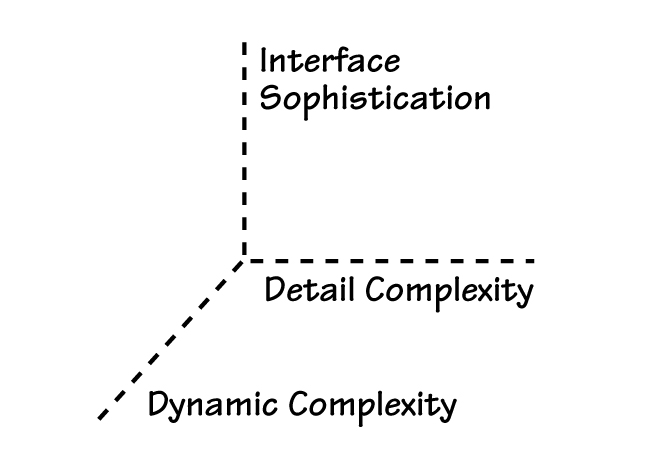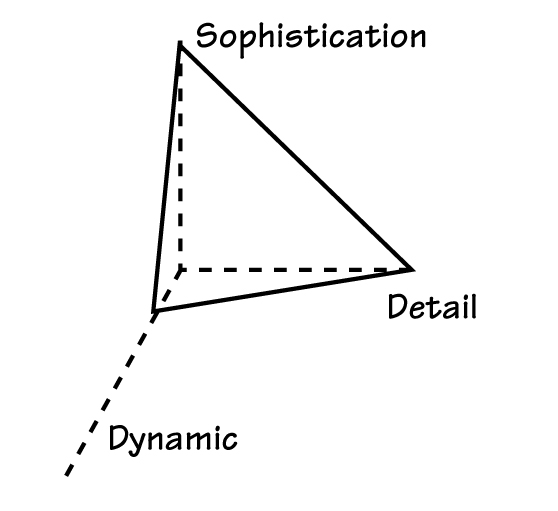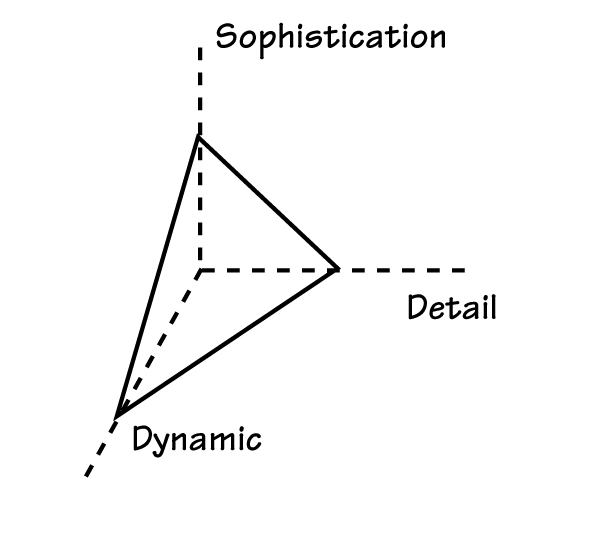Experiential activities have long been recognized as powerful ways to learn. Simulations create an environment where people can encounter many of the challenges and frustrations of life in a complex system. The Beer Distribution Game, Fish Banks, People Express™ have become effective, popular ways of enhancing learning through and active participation in a system less mysterious than the real world – but with enough of its characteristics to provide a rich experience. Such participation typically involves both playing a simulation and debriefing the experience to expose the role of underlying systemic structure. The whole activity is often called a learning laboratory.
A learning laboratory consists of three key components. A dynamic simulation model captures the model designer’s understanding of the business system, including its structure, the marketplace, and the competitive environment. A user interface presents simulation results year-by-year, allowing users to make new decisions that are then fed back into the simulation. Finally, an experiential workshop gives participants an opportunity to play the simulation and then debrief the results. The learning laboratory provides a means for participants to experience and learn about important issues without endangering the actual organization.
Design Trade-offs
Many decisions must be made in creating a learning lab. These decisions include both big ones (what type of issues the simulation should address) and small ones (what type of computer equipment to use). Three critical factors that drive many of these design choices are the levels of detail complexity, dynamic complexity, and simulator interface sophistication included in the learning lab. These can be summarized on a three-dimensional axis (see “Learning Lab Design Trade-offs”).
LEARNING LAB DESIGN TRADE-OFFS

A high degree of detail complexity is characterized by a large amount of detailed information about the business system. High detail complexity ratchets up the challenge of developing the learning lab because it increases the time spent on design, development, data collection, and testing. Pressure from clients to include large amounts of detail can also complicate matters. (Many clients erroneously assume that more detail automatically leads to more realism, and that more realism leads to more learning.)
A simulation or learning lab with high dynamic complexity contains a model with a robust underlying structure that captures feedback and time delays present in the system. A wide range of possible behaviours may emerge from such a simulation. Consequently, designing a workshop that lets participants experience and learn about those many behaviors becomes an important consideration in the decision to incorporate high levels of dynamic complexity into the simulation.
The level of interface sophistication involves the aspect of the simulation that is visible to the user. It includes the type and manner of user input, as well as the presentation of simulation results. Increased sophistication in the interface (for example,the inclusion of on-line help, multimedia,or other technological features) can enhance ease of use and make the simulator more appealing. Note, however, that an overly sophisticated interface can significantly add to the cost of the simulation, and may overwhelm users or distract them from learning if the interface resembles a video game too closely. A simulator with a compelling story and a select number of interesting dynamics engages participants just as powerfully as an elaborate multimedia simulator interface.
As we discuss below, the various trade-offs among design issues produce different experiences for participants. Deliberate consideration of these trade-offs in light of the learning goals is key to successfully meeting those goals.
Focus on Operational Learning
OPERATIONAL LEARNING MODEL

Some simulators may be designed to teach users how to maximize operational effectiveness (see “Operational Learning Model”on p. 7). Examples of issues addressed in this kind of simulation might include controlling production flows in a plant, managing an R&D pipeline in a consumer goods company, or making French fries in a fast food restaurant. Typically, such a simulator will have a high amount of detail complexity and a high degree of interface sophistication. Users see a realistic representation of the business unit and receive immediate feedback on the effectiveness of their decisions. The experience is highly engaging, at least at first. However, the simulator rarely includes time delays, accumulations, or other dynamic subtleties to sustain ongoing interest. Users learn a significant amount about operating the business activity but little about the systemic, long-term factors that underlie the business.
Stress the Dynamics
CLASSIC MODEL

Traditional system dynamics models examine the often-misunderstood long-term dynamics of business and social systems(see “Classic Model”). Classic models,such as those that focus on the behaviors of industries, cities, and worldwide population growth, were designed as high-level,generic representations of the issues.
Such models take into account powerful long-term trends and fundamental changes,and can produce important insights.Unfortunately, the high level of abstraction and the lack of an easy-to-use interface can make these simulations difficult to understand by those not directly involved in their creation.
Mask the System
GAMING SIMULATION MODEL

In the last few years, commercial vendors have produced a number of sophisticated gaming simulations, of which SimCity by Maxis is probably the most popular (see “Gaming Simulation Model”). These simulations are costly to develop, because they contain extensive multimedia interfaces and a high level of detail. Often a sophisticated, highly dynamic model supports the simulation. However, users sometimes have difficulty handling the bewildering array of information on the screens and the enormous number of decisions they must make in using these products. The learning from these simulations is operational rather than systemic and often lacks focus.
Ideal for Systemic Learning
SYSTEMIC LEARNING MODEL

A simulator intended to help users learn about a business system includes a balance of the three design drivers (see “Systemic Learning Model”). Such a simulator contains just enough detail to make the simulation tangible to users. The interface is just sophisticated enough to make the experience easy, interesting, and fun. This simulator also features a high degree of dynamic complexity in the underlying model, to provide rich, subtle responses to user decisions. It is this dynamic complexity that promotes systemic learning, and that provokes exclamations of “Ah-ha!” as users encounter unexpected but subsequently explainable results.
Creating a Successful Learning Experience
A final note: To create a successful learning laboratory, designers must help participants shift their mental models from focusing on winning to focusing on learning. A learning laboratory should provide a means for participants to design strategies, assess outcomes, and discuss ideas with other players. This format includes encouraging “far-out” approaches that test the limits of the situation and create an exciting atmosphere where players want to take risks and make mistakes in order to truly learn. In short, a learning laboratory should help participants really perform on a management practice field, not just play a simulation game.
William Glass-Husain is a senior consultant with the Simulator Solutions Group of the Powersim Corporation. David W. Packer is a founding member of the Systems Thinking Collaborative, a network of consulting capability in systems thinking and system dynamics.
This article stems from work done by the authors at GKA Incorporated and elsewhere on multiuser learning laboratories.
